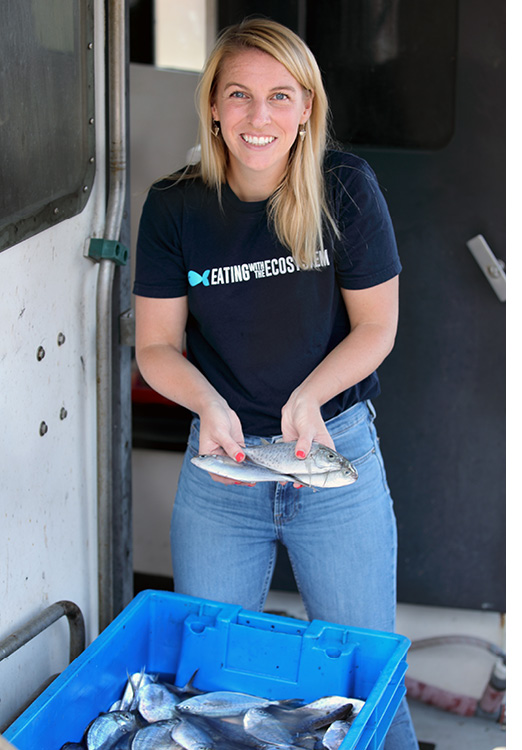
© Markham Starr
As Program Director with a non-profit organization in Warren, Rhode Island called Eating with the Ecosystem, Kate Masury loves her work.
“I grew up in Kittery Point, Maine and spent a lot of time in the summer on an island off the coast near Damariscotta,” says Kate, who lives in Newport. “I’ve been interested in the ocean my whole life. My favorite food from the time I was a toddler has always been lobster, and I spent as much time as possible as a kid exploring tidepools and the beach. I’ve had a number of great mentors, and one of my first was my high school art teacher. I’d always really loved art, but the two of us connected over the inspiration we drew from nature and she very much encouraged me to pursue my passions. For me, those were seafood and the ocean.”
“I decided to attend Scripps Institute of Oceanography (SIO) after working in the marine science education field for a few years. I had been teaching kids about ocean ecosystems in outdoor settings such as field stations and on boats, and realized that while I thoroughly enjoyed being out in the field and teaching kids about a topic I love, I didn’t want any of my bosses’ jobs (which take you away from actual education work). I love the ocean and the organisms that live there, but I also very much enjoy eating them and my connection with animals as food further inspired me to protect the ecosystems that produce them. I grew up in a community where there were a lot of fishermen and I very much respected how hard they work and their connection to the ocean. I decided to attend SIO in an interdisciplinary program where I could focus on sustainable seafood and fisheries. Because seafood crosses so many different disciplines, this program was right for me because I could study ecological science as well as the social sciences, economics, policy, etc.”
Kate’s capstone project at SIO was called ‘Follow Your Fish.’ “I partnered with one of my classmates who was also interested in seafood to create a website that told the story of three different seafood supply chains and the people and businesses involved,” she says. “As consumers we tend to be very disconnected from our seafood, and one goal with this project was to give consumers a better understanding of where their seafood comes from. I studied the supply chains of the Maine lobster and California spiny lobster, and my friend studied California market squid.”
“Eating with the Ecosystem promotes a place-based approach to sustaining New England’s wild seafood, through flourishing food webs, healthy habitats, and short, adaptive seafood supply chains,” Kate explains. “Our vision is a New England seafood system that supports the region’s marine ecosystems and the people who depend on them, and we’re committed to pioneering a unique solution to the challenges of sustaining wild-caught fisheries. We are a very small organization and I am the only full-time employee, but we have a Board of Directors made up of fishermen, scientists, chefs, food system leaders, and non-profit professionals. We also have a great Advisory Network made up of chefs, seafood supply chain businesses, fishermen, and scientists.”
“At least a hundred edible wild species thrive in the salty waters off New England’s shores. But how often are species like butterfish, scup, John Dory, dogfish, periwinkles, sea robin, skate, and razor clams offered for sale in the local marketplace? This is the question that 86 intrepid seafood lovers set out to answer when they embarked on a data quest called Eat Like a Fish. This one-of-a-kind, citizen science research project included weekly shopping expeditions, home cooking experiments, and adventurous dinner table taste tests. Journeying to seafood markets, supermarkets, farmers’ markets and fishing piers, participants hunted for 52 New England seafood species for 26 weeks (at a rate of four randomly assigned species per person per week), noting where they found them and where they didn’t. When they found them, they took them home for dinner. Their first goal was to understand how well New England’s retail marketplace reflects the diversity of wild seafood in nearby ocean ecosystems. Their second goal was to draw on their experiences to help explain why these mismatches exist, and what can be done to correct them.”
Through a partnership between the University of Rhode Island and Johnson & Wales University College of Culinary Arts, Eating with the Ecosystem has produced a cookbook called Simmering the Sea: Diversifying Cookery to Sustain Our Fisheries It features recipes for forty underappreciated fish and shellfish from the northwest Atlantic, including the mostly unloved sea robin. “Sea robins are not only edible, they are delicious!” says Kate. “Their meat has a mild, yet sweet flavor. You can bake it, pan sear it, fry it, and even eat it raw!”
“This summer and fall we are holding a number of our Scales & Tales Food Boat events at farmer’s markets in Massachusetts, and talks, dinners and cooking classes around the region. The best way to find out about them is to follow Eating with Ecosystem on social media and to check out the events calendar on our website, eatingwiththeecosystem.org. If you’re unable to attend one of our events, you can get involved by joining our online seafood club via Facebook group New England Seafoodies and following and using the #SeafoodiesNE on Instagram.”
“One of my favorite parts of my job is getting to interact with so many different people,” says Kate. “I love building relationships with fishermen and chefs as well as consumers. One of the most rewarding things is when people who I have talked to about local seafood share with me all the new species they have tried.” ■




